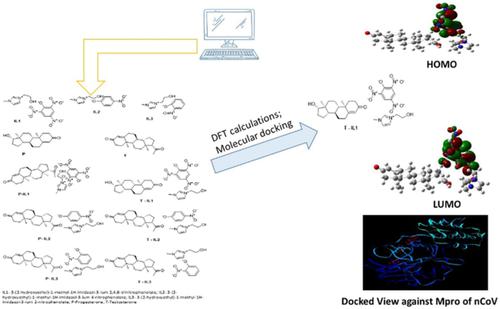当前位置:
X-MOL 学术
›
J. Phys. Org. Chem.
›
论文详情
Our official English website, www.x-mol.net, welcomes your feedback! (Note: you will need to create a separate account there.)
Investigate the interaction of testosterone/progesterone with ionic liquids on varying the anion to combat COVID-19: Density functional theory calculations and molecular docking approach
Journal of Physical Organic Chemistry ( IF 1.8 ) Pub Date : 2021-08-18 , DOI: 10.1002/poc.4273 Kamlesh Kumari 1 , Ajay Kumar 2 , Indra Bahadur 3 , Prashant Singh 4
Journal of Physical Organic Chemistry ( IF 1.8 ) Pub Date : 2021-08-18 , DOI: 10.1002/poc.4273 Kamlesh Kumari 1 , Ajay Kumar 2 , Indra Bahadur 3 , Prashant Singh 4
Affiliation

|
Hormones like testosterone and progesterone in the humans play significant role in the regulation of various biological processes like the body growth, reproduction, and others. In last two decades, researchers are using ionic liquids (ILs) extensively in different areas of sciences, and they are a novel class of compounds as well as their polarity can be tuned. ILs are multidisciplinary in nature and can be used in chemistry, materials science, chemical engineering, and environmental science. Further, ILs are being explored to increase the solubility of drugs or biological potential molecules. Testosterone and progesterone are found to be not very polar in nature; therefore, the authors attempt to increase the solubility of testosterone and progesterone via interaction with ILs. It was studied with density functional theory calculations using Gaussian, and an increase in the value of dipole moment is observed for the complex of testosterone/progesterone with the ILs in comparison of individual one. The optimization energy and other thermodynamic energies of the ILs (IL1-IL3), testosterone (T), testosterone-IL (T-IL1 to T-IL3), progesterone (P), and progesterone-ILs (P-IL1 to P-IL3) are found to be negative. Further, the change in free energy for the formation of complexes at room temperature is calculated. Further, the authors have investigated the synergistic effect of testosterone and progesterone against the main protease of new coronavirus using molecular docking. It is observed that the testosterone-IL1 {IL1-3-(2-hydroxyethyl)-1-methyl-1H-imidazol-3-ium 2,4,6-trinitrophenolate} is found to be prominent against the main protease of SARS-CoV-2.
中文翻译:

研究睾酮/孕酮与离子液体对改变阴离子对抗 COVID-19 的相互作用:密度泛函理论计算和分子对接方法
人体中的睾酮和黄体酮等激素在调节身体生长、繁殖等各种生物过程中发挥着重要作用。在过去的二十年里,研究人员在不同的科学领域广泛使用离子液体 (ILs),它们是一类新型化合物,并且它们的极性可以调节。IL本质上是多学科的,可用于化学、材料科学、化学工程和环境科学。此外,正在探索 ILs 以增加药物或生物潜在分子的溶解度。睾酮和黄体酮在本质上不是很极性。因此,作者试图通过与 ILs 的相互作用来增加睾酮和孕酮的溶解度。使用高斯通过密度泛函理论计算对其进行了研究,与单独的相比,睾酮/孕酮与 ILs 的复合物的偶极矩值增加。IL (IL1-IL3)、睾酮 (T)、睾酮-IL (T-IL1 到 T-IL3)、孕酮 (P) 和孕酮-IL (P-IL1 到 P-) 的优化能量和其他热力学能量IL3) 为阴性。此外,计算了在室温下形成络合物的自由能变化。此外,作者还利用分子对接研究了睾酮和孕酮对新冠病毒主要蛋白酶的协同作用。据观察,睾酮- 与个体相比,睾酮/孕酮与 ILs 的复合物的偶极矩值增加。IL (IL1-IL3)、睾酮 (T)、睾酮-IL (T-IL1 到 T-IL3)、孕酮 (P) 和孕酮-IL (P-IL1 到 P-) 的优化能量和其他热力学能量IL3) 为阴性。此外,计算了在室温下形成络合物的自由能变化。此外,作者还利用分子对接研究了睾酮和孕酮对新冠病毒主要蛋白酶的协同作用。据观察,睾酮- 与个体相比,睾酮/孕酮与 ILs 的复合物的偶极矩值增加。IL (IL1-IL3)、睾酮 (T)、睾酮-IL (T-IL1 到 T-IL3)、孕酮 (P) 和孕酮-IL (P-IL1 到 P-) 的优化能量和其他热力学能量IL3) 为阴性。此外,计算了在室温下形成络合物的自由能变化。此外,作者还利用分子对接研究了睾酮和孕酮对新冠病毒主要蛋白酶的协同作用。据观察,睾酮- 和孕酮-ILs (P-IL1 到 P-IL3) 被发现是阴性的。此外,计算了在室温下形成络合物的自由能变化。此外,作者还利用分子对接研究了睾酮和孕酮对新冠病毒主要蛋白酶的协同作用。据观察,睾酮- 和孕酮-ILs (P-IL1 到 P-IL3) 被发现是阴性的。此外,计算了在室温下形成络合物的自由能变化。此外,作者还利用分子对接研究了睾酮和孕酮对新冠病毒主要蛋白酶的协同作用。据观察,睾酮-发现IL1 {IL1-3-(2-hydroxyethyl)-1-methyl-1H-imidazol-3-ium 2,4,6-trinitrophenolate} 对 SARS-CoV-2 的主要蛋白酶具有显着的抗性。
更新日期:2021-08-18
中文翻译:

研究睾酮/孕酮与离子液体对改变阴离子对抗 COVID-19 的相互作用:密度泛函理论计算和分子对接方法
人体中的睾酮和黄体酮等激素在调节身体生长、繁殖等各种生物过程中发挥着重要作用。在过去的二十年里,研究人员在不同的科学领域广泛使用离子液体 (ILs),它们是一类新型化合物,并且它们的极性可以调节。IL本质上是多学科的,可用于化学、材料科学、化学工程和环境科学。此外,正在探索 ILs 以增加药物或生物潜在分子的溶解度。睾酮和黄体酮在本质上不是很极性。因此,作者试图通过与 ILs 的相互作用来增加睾酮和孕酮的溶解度。使用高斯通过密度泛函理论计算对其进行了研究,与单独的相比,睾酮/孕酮与 ILs 的复合物的偶极矩值增加。IL (IL1-IL3)、睾酮 (T)、睾酮-IL (T-IL1 到 T-IL3)、孕酮 (P) 和孕酮-IL (P-IL1 到 P-) 的优化能量和其他热力学能量IL3) 为阴性。此外,计算了在室温下形成络合物的自由能变化。此外,作者还利用分子对接研究了睾酮和孕酮对新冠病毒主要蛋白酶的协同作用。据观察,睾酮- 与个体相比,睾酮/孕酮与 ILs 的复合物的偶极矩值增加。IL (IL1-IL3)、睾酮 (T)、睾酮-IL (T-IL1 到 T-IL3)、孕酮 (P) 和孕酮-IL (P-IL1 到 P-) 的优化能量和其他热力学能量IL3) 为阴性。此外,计算了在室温下形成络合物的自由能变化。此外,作者还利用分子对接研究了睾酮和孕酮对新冠病毒主要蛋白酶的协同作用。据观察,睾酮- 与个体相比,睾酮/孕酮与 ILs 的复合物的偶极矩值增加。IL (IL1-IL3)、睾酮 (T)、睾酮-IL (T-IL1 到 T-IL3)、孕酮 (P) 和孕酮-IL (P-IL1 到 P-) 的优化能量和其他热力学能量IL3) 为阴性。此外,计算了在室温下形成络合物的自由能变化。此外,作者还利用分子对接研究了睾酮和孕酮对新冠病毒主要蛋白酶的协同作用。据观察,睾酮- 和孕酮-ILs (P-IL1 到 P-IL3) 被发现是阴性的。此外,计算了在室温下形成络合物的自由能变化。此外,作者还利用分子对接研究了睾酮和孕酮对新冠病毒主要蛋白酶的协同作用。据观察,睾酮- 和孕酮-ILs (P-IL1 到 P-IL3) 被发现是阴性的。此外,计算了在室温下形成络合物的自由能变化。此外,作者还利用分子对接研究了睾酮和孕酮对新冠病毒主要蛋白酶的协同作用。据观察,睾酮-发现IL1 {IL1-3-(2-hydroxyethyl)-1-methyl-1H-imidazol-3-ium 2,4,6-trinitrophenolate} 对 SARS-CoV-2 的主要蛋白酶具有显着的抗性。


























 京公网安备 11010802027423号
京公网安备 11010802027423号